
About UsThe Numismatic Bibliomania Society is a non-profit organization promoting numismatic literature. For more information please see our web site at coinbooks.org SubscriptionsThose wishing to become new E-Sylum subscribers (or wishing to Unsubscribe) can go to the following web page link MembershipThere is a membership application available on the web site Membership Application To join, print the application and return it with your check to the address printed on the application. Membership is only $15 to addresses in the U.S., $20 for First Class mail, and $25 elsewhere. For those without web access, write to: David M. Sundman, Secretary/TreasurerNumismatic Bibliomania
Society AsylumFor Asylum mailing address changes and other membership questions, contact David at this email address: dsundman@LittletonCoin.com SubmissionsTo submit items for publication in The E-Sylum, just Reply to this message, or write to the Editor at this address: whomren@coinlibrary.com
BUY THE BOOK BEFORE THE COINYou won't regret it! |
- WAYNE'S WORDS: THE E-SYLUM APRIL 24, 2011
- SKLOW LITERATURE SALE #13 CLOSES JUNE 11, 2011
- KOLBE & FANNING 2011-2012 NUMISMATIC LITERATURE SALE CALENDAR
- LAKE BOOKS 107TH MAIL-BID SALE CLOSES APRIL 26, 2011
- NEW BOOK: COINS OF INDIAN STATES - PART A
- NEW BOOK: FLORIDA PAPER MONEY SOFTCOVER EDITION
- BOOK REVIEW: THE SECRET HISTORY OF THE FIRST U.S. MINT
- AUTHOR'S RESPONSE TO REVIEW OF AGRICULTURAL AND MECHANICAL SOCIETY AWARD MEDALS BOOK
- MORE ON BOOKBINDER ALLAN GRACE
- THE COIN CABINET IN THE FITZWILLIAM MUSEUM, CAMBRIDGE
- MORE ON TRUTH IN LABELING FOR PRINT ON DEMAND LISTINGS
- BEP LAUNCHES EYENOTE APP TO HELP THE BLIND
- APP REVIEW: THE E-SYLUM
- APP REVIEW: COIN WORLD IPAD APP
- THE 2011 BROOKGREEN GARDENS MEDAL BY SIMON KOGAN
- RATS OF TOBRUK MEDAL RECIPIENT FRANCIS PETER BINGHAM
- MORE ON MEDAL OF HONOR CERTIFICATES
- NOTES FROM E-SYLUM READERS: APRIL 24, 2011
- BALDWIN'S CHINESE COIN AUCTION RESULTS
- TERMITES EAT MILLIONS OF INDIAN RUPEES IN BANK
- THE VATICAN COIN AND MEDAL COLLECTION
- U.S. GOLD COIN HOARD FOUND IN EAST LONDON RETURNED TO OWNER'S FAMILY
- STOLEN WWII DISTINGUISHED SERVICE ORDER MEDAL RETURNED TO OWNER
- FAKE U.S. COINS FROM CHINA SEIZED AT CHICAGO AIRPORT
- VERMONT ARTIST CREATES FURNITURE USING COINS
- QUEEN ELIZABETH'S BUSY WEEK
- THE CAMBRIDGE UNIVERSITY NORRISIAN PRIZE MEDAL
- FEATURED WEB PAGE: LUXURY LIBRARIES IN EUROPE
WAYNE'S WORDS: THE E-SYLUM APRIL 24, 2011

Among our new subscribers this week are Mike Buckley, L. Weinberg, Greg Adams, Ronald Chauvin, and Michael Hoffman. Welcome aboard! We now have 1,422 email subscribers, plus 130 followers on Facebook, including Lona Young and Matthew Jenkins.
Earlier this week Krause Publications' NumisMaster web site announced that they'd surpassed the 5,000 article mark. The E-Sylum has been around a lot longer, so I was curious and asked John Nebel (who kindly hosts the NBs web site for us) about our current article count. Drum roll, please.... Total number of issues: 662 . Total number of articles: 13,300. Wow! We couldn't do this without a lot of help each week from our readers and regular contributors. Thanks! We've built up quite a body of work, and all of it is available on the NBS web site.
This week we open with updates from three numismatic literature dealers, announcements of two new books, and a review of The Secret History of the First U.S. Mint. Also in this issue are reviews and announcements of three smartphone apps related to numismatics.
To learn more about the Coin Cabinet of the Fitzwilliam Museum in Cambridge, the 2011 Brookgreen Gardens Medal, and the money-eating termites, read on. Have a great week, everyone!
Wayne Homren
Numismatic Bibliomania Society
SKLOW LITERATURE SALE #13 CLOSES JUNE 11, 2011
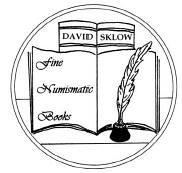 From the research & source library of Q. David Bowers are offered over 300 lots on numismatics.
Including an American Bond Detector; an Original set of Numisma by Frossard; set number 5 of the
deluxe bound Armand Champa Library catalogs; letters between QDB and John J. Ford, Jr.; the
paste-up plates for the Taylor sale of Colonials 1987; super deluxe presentation copy number 2 of the
Eliasberg & Brand collections; a set of The Essay Proof Journals; special, priced, large paper, bound,
Cogan Sale of the J.K. Wiggins Collection; six works by Snelling bound in one volume; over 125
Director of the Mint reports 1852-1977; Bankers Magazine and Statistical Register, ex: John J. Ford
Jr.; 65 lots of Bank Histories;
From the research & source library of Q. David Bowers are offered over 300 lots on numismatics.
Including an American Bond Detector; an Original set of Numisma by Frossard; set number 5 of the
deluxe bound Armand Champa Library catalogs; letters between QDB and John J. Ford, Jr.; the
paste-up plates for the Taylor sale of Colonials 1987; super deluxe presentation copy number 2 of the
Eliasberg & Brand collections; a set of The Essay Proof Journals; special, priced, large paper, bound,
Cogan Sale of the J.K. Wiggins Collection; six works by Snelling bound in one volume; over 125
Director of the Mint reports 1852-1977; Bankers Magazine and Statistical Register, ex: John J. Ford
Jr.; 65 lots of Bank Histories;
The sale also features classic selections from the library of numismatic publisher and literature dealer Myron Xenos, to include hundreds of 19th and 20th century auction catalogs, An Essay on Medals by Pinkerton, and numerous works on coinage of China, Japan and the Far East.
Over one thousand-three hundred color photographs of Large Cents 1816-1843 by William Noyes.
Library from New Mexico, featuring deluxe bound auction catalogs, numerous standard reference works, some deluxe editions and original Early Coins of America by Crosby.
A beautiful example of Medals & Medallions Relating to Architects by Eidlitz.
Badges & Medals of the American Numismatic Association, from the estate of Rollie Finner. Including the very rare 1991Centennial three piece medals set, bronze, silver & gold in special presentation wooden box.
Bidders may enter bids by mail, telephone, email or fax. The sale closes at 8pm mountain time, June 11, 2011, however, any bids left on our answering machines or sent by email or fax on or before midnight on closing day will be accepted.
The most "dedicated" Numismatic Literature Auction firm in the United States
Sale Catalog is now viewable on our website. Individuals on our mailing list will have their copy mailed on or about May 9th. Catalogs are available upon request at no charge.
DAVID SKLOW – FINE NUMISMATIC BOOKS
P.O. BOX 6321
COLORADO SPRINGS, CO 80934
TEL: (719) 302-5686
FAX: (719) 302-4933
finenumismaticbooks@aol.com
www.finenumismaticbooks.com
KOLBE & FANNING 2011-2012 NUMISMATIC LITERATURE SALE CALENDAR
George Kolbe writes:
Our sale calendar information follows:
- SALE 121: June 2, 2011
- SALE 122: September 15, 2011
- SALE 123: November 10, 2011
- SALE 124: January 7, 2012
- SALE 125: February 23, 2012
LAKE BOOKS 107TH MAIL-BID SALE CLOSES APRIL 26, 2011
This is a reminder that Lake Books' 107th mail-bid sale of numismatic literature will close on Tuesday, April 26, 2011 at 5:00 PM (EDT). The sale features selections from the library of Eric von Klinger, Part Two and contains 501 lots of reference material covering the entire spectrum of the numismatic experience. You may view the catalog at http://www.lakebooks.com/current.html
The next sale is scheduled for Tuesday, July 12, 2011 and will offer books and catalogs from the library of Lucien (Lou) Philippon. You may place your bids via email, fax, or the telephone until the closing time. Remember to bid early as ties are won by the earliest bid received. Good luck with your bidding, Fred
Lake Books
6822 22nd Ave. N.
St. Petersburg, FL 33710
727-343-8055 Fax 727-345-3750
NEW BOOK: COINS OF INDIAN STATES - PART A
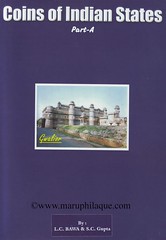 Here's a golden opportunity to enhance your knowledge about the Coins of India States. We are introducing the book "Coins of Indian States - Part A" by L. C. Bawa & S. C. Gupta for the 1st time on our website.
Here's a golden opportunity to enhance your knowledge about the Coins of India States. We are introducing the book "Coins of Indian States - Part A" by L. C. Bawa & S. C. Gupta for the 1st time on our website.
This is in the honor of Late Sh. L. C. Bawa who was the secretary of the Delhi Coin Society.
"State Coins" denotes coins of Indian Princely States, which though pledging sovereignty with Mughals & even British, continued to issue coins independently. Since this book is a limited edition you can book this issue through online & collect it at our 1st National Numismatic Exhibition venue which will be held from May 6th to May 8th 2011 at The Bell Hotel, Majestic - Bangalore.
This Book Contains:-
- 1. Around 250 colored printed glossy pages.
- 2. Map of Un-Divided India showing location of States.
- 3. A list of all India States at the time of Partition of India & Pakistan in 1947A.D
- 4. A list of British Rulers of India before 1947 A.D
- 5. A list of Mughal Rulers of India before 1947 A.D
- 6. Formula for Converting Eras to Anno Domino & Numerals in three languages.
- 7. Comparative Table of Years of Hejira & Christian Era.
- 8. A simple formula to learn Urdu language.
Cost of the book would be Rs. 750 or 25 USD.
The cost of book itself is very nominal. In case you are unable to visit our exhibition then we can also ship it out to you at an extra cost of Rs. 150 anywhere in India & 10 USD anywhere out of India.
For more information on banking details kindly visit the following link: www.maruphilaque.com/content.asp?file=Banking-Detail
NEW BOOK: FLORIDA PAPER MONEY SOFTCOVER EDITION
Author Ron Benice writes:
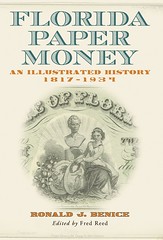 McFarland & Company, publishers of my Florida Paper Money: An Illustrated History, 1817-1934, announced that the hardcover edition published in January 2008 at $49.95 is sold out and they have reprinted it as a softcover book at $35. The insides and front cover are unchanged; the back cover has been updated to include excerpts from reviews.
McFarland & Company, publishers of my Florida Paper Money: An Illustrated History, 1817-1934, announced that the hardcover edition published in January 2008 at $49.95 is sold out and they have reprinted it as a softcover book at $35. The insides and front cover are unchanged; the back cover has been updated to include excerpts from reviews.
BOOK REVIEW: THE SECRET HISTORY OF THE FIRST U.S. MINT
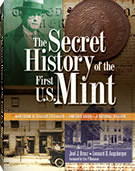 This much anticipated work by Joel Orosz and Len Augsburger was released just in time for marketing at the Whitman Baltimore show earlier this month. In their introduction, the authors discuss how this began as two separate, much smaller projects that morphed into something far larger and far more complex than either had anticipated. For the reader, it's absolutely worth it. This is a well-told story about American coinage history, art history, early efforts at urban archaeology and one man's dream. At 250 very profusely illustrated 8½ x 11" pages, it is crammed with information about Philadelphia businessman Frank Huling Stewart who purchased the property that comprised the first Philadelphia Mint (the one that produced all of the coins minted from late 1792-1835), tried to save some of the buildings, and ultimately had them all demolished to build a larger location for his electrical supply business. Whitman Publishing is to be congratulated for bringing an excellent volume out and at a very reasonable $24.95 cover price.
This much anticipated work by Joel Orosz and Len Augsburger was released just in time for marketing at the Whitman Baltimore show earlier this month. In their introduction, the authors discuss how this began as two separate, much smaller projects that morphed into something far larger and far more complex than either had anticipated. For the reader, it's absolutely worth it. This is a well-told story about American coinage history, art history, early efforts at urban archaeology and one man's dream. At 250 very profusely illustrated 8½ x 11" pages, it is crammed with information about Philadelphia businessman Frank Huling Stewart who purchased the property that comprised the first Philadelphia Mint (the one that produced all of the coins minted from late 1792-1835), tried to save some of the buildings, and ultimately had them all demolished to build a larger location for his electrical supply business. Whitman Publishing is to be congratulated for bringing an excellent volume out and at a very reasonable $24.95 cover price.
This is really the story of Stewart (born Steward) more than that of the Mint, and a fascinating story it is. Stewart was a self-made man. From his early life on the family farm to his career in the electrical supply business, to his later community boosting, sport fishing and philanthropic activities, this book tells it all: his motivations for buying the old Mint property and for trying to save it, for demolishing it and for preserving as much of it as he could and donating it for public display. Stewart was first and foremost a businessman and promoter. He painted ‘1792 "YE OLDE MINT"' in huge letters on the front of the original building and then sold lines of electrical supplies that he called "Old Mint" and "Stewart's Old Mint Gold Standard." The authors do a great job of getting into his head and making him accessible to us.
Part of the story of Stewart's work with the Mint property was told in Stewart's own 1924 book, but Orosz and Augsburger expand greatly on that material, and their efforts correct a number of inadvertent errors that Stewart made. His largest error? The brick building Stewart considered the "Coinage Building" and the first built in 1792 by and for the fledgling US Government was neither used for coinage nor built until 1816, when it replaced an earlier wood frame edifice destroyed by the Mint fire of early 1816. Many collectors are familiar with the painting of the three buildings of "Ye Olde Mint" that Stewart commissioned, but Augsburger and Orosz tell us there were TEN buildings in the early Mint complex and that they were crowded into the middle of an urban block, not the bucolic view from the famous Lamasure painting now on display at the Fourth Mint in Philadelphia. They even have a new, much more accurate and very different view, produced by Pete Smith, of what the Mint buildings really looked like in their actual environment. Rittenhouse, the first Director, apparently picked the site because of its proximity to his own house, but for many reasons well documented in the book, it was inadequate for the government's needs, almost from the beginning. The authors clearly document the complex' expansion over its 40+ years of service, using excellent illustrations.
They also carefully researched the history of the two famous but apocryphal Mint-related paintings Stewart commissioned: Edwin Lamasure's "Ye Olde Mint" and John Dunsmore's "Washington Inspecting the First Money Coined by the United States". Both are now on display at the Philadelphia Mint, but how they got there tells a fascinating pair of stories that I won't spoil for you. The chapters about these paintings had perhaps too much information for my tastes, and I'm an art lover, but I consider any quibble about too much information to be very minor, indeed.
Stewart saved as much as he could from the destroyed Mint, including furniture, timbers (several were turned into gavels), a boot scraper and discarded small pieces of apparatus for producing coins. He also found and saved coins and planchets from the site, including two silver center cent planchets, as well as several pieces of scissel, the leftover strip from which planchets had been cut. There is a copper trial strike of a 1795 half dime. These are all illustrated by new color photographs. Stewart donated all of these to the Congress Building, one wing of Independence Hall, where they were to have been on permanent exhibit. Alas, permanent exhibits have a way of becoming impermanent. Much of the material spent many years in storage, and some was lost. Fortunately, most of it is still with the collection and on display at the Fourth Philadelphia Mint, a few blocks from the First Mint. Again, I won't spoil the authors' interesting story of how they got there.
Stewart even proved to be a numismatist, having published good work on the enigmatic St. Patrick half pence coinage associated with Mark Newby in The Numismatist and later expanding that work into a pamphlet.
My only other complaint – and I am nitpicking – is that the book could have used a bit tighter job of editing. There are places where information is repeated, and there are a few places where dates are inconsistent, but I found no significant errors of fact and very few typos.
Orosz and Augsburger have done a very solid, scholarly job, using primary source material throughout and clearly sourcing their findings. Where their findings are uncertain or depend on educated guesswork, they say so very clearly. The source material is discretely located in endnotes, so if the reader doesn't care about the sources, he doesn't have to be distracted by them; if he does, they are easy to find. In his forward, Eric Newman says this book is "outstandingly presented." I agree with Eric. If you have any interest at all in the First United States Mint, you should buy this book. What more can a reader ask than a fascinating story that is outstandingly presented? Read and enjoy!
Dave Lange adds:
I want to add my voice to the chorus of cheers for The Secret History of the First U. S. Mint. Joel and Len did a truly outstanding job in making this a compelling read that I'm now close to finishing. It is so well researched and written, and it goes into so many intriguing sidebar stories, that there is really something to please everyone. Every year sees a crop of popular books in American numismatics that offer little in the way of new research and interpretation, and that makes this volume truly memorable. I'm so jealous that I didn't write it myself, but I'm certainly glad that they did.
AUTHOR'S RESPONSE TO REVIEW OF AGRICULTURAL AND MECHANICAL SOCIETY AWARD MEDALS BOOK
Tim Corio writes:
I am forwarding Andy Harkness' response to Dick Johnson's review of our book Agricultural and Mechanical Society Award Medals Of The United States, Second Edition that was published in E-Sylum, Volumn 13, Number 51, December 19, 2010.
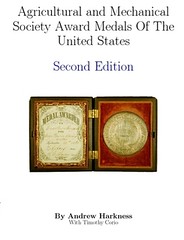 I am anxious to attempt to contact all of the those who read my old
friend Dick Johnson's review of my book Agricultural and Mechanical
Society Award Medals Of The United States, Second Edition in your
publication.
I am anxious to attempt to contact all of the those who read my old
friend Dick Johnson's review of my book Agricultural and Mechanical
Society Award Medals Of The United States, Second Edition in your
publication.
Please forgive the incomplete offering I presented through lulu.com. I am a collector and historian obsessed with a 40+ year project of great challenge. Most of my project was completed before eBay came along. With the assistance of several people supplying me from eBay, I brought the collection's loose ends essentially together in recent years.
I thought that my findings would have to be shared through an estate auction. However, good friend Tim Corio, fellow member of the Rochester Numismatic Association, caught me by surprise.
I am 76 years old and have been in declining health for ten years. Tim offered to assist me with his wonderful expertise in photography and in preparing the essentials of my collection for a book.
I took on the task of organizing a complete type grouping of the medals and preparing the catalog numbering system and he did the rest – God Bless him! It took us a year.
We knew that our offering had warts. But it's the best I can do at this end stage of life... a first effort to catalog this subject in the finest quality paper we could find.
But our consciences are clear because any viewer of our lulu.com page can review the entire book for free on line!!! If you need the quality photos, you'll have to cough up the purchase price.
I do have much support data and enthusiasm stored in my library and in my head and love to discuss the subject. I am available most evenings 7:30-9:00 to talk at 585-248-3899.
Sincerely,
Andrew Harkness
P.S. I must warn any caller that I break into tears whenever some one asks me to destroy the collection's integrity by selling him the pieces from some state or region.
To read the earlier E-Sylum article, see: BOOK REVIEW: AGRICULTURAL AND MECHANICAL SOCIETY MEDALS OF THE U.S. (www.coinbooks.org/esylum_v13n51a07.html)
MORE ON BOOKBINDER ALLAN GRACE
Dave Lange writes:
I was saddened to read of Allan Grace's passing. It was always a pleasure to work with him, as he genuinely enjoyed his craft. Alan bound the limited, leatherbound editions of the three books I wrote as part of the Complete Guide series. I had him prepare 25 of each, Number One always going to Armand Champa, and Number Two remaining with me. I'm attaching a couple of scans that give some impression of the quality of his work, though this is already well known to readers of The E-Sylum.
I also had him bind my set of Wilson's Numismatic Repository, and the result was especially pleasing. I was going to call upon him again for my coin board book, but the expense of self-publishing precluded taking this step at the time. I'd found that the market for these limited editions seemed to decline a bit after Armand's passing, and copies of the last one I did lingered for awhile. I still have ten untrimmed sets of signatures for the coin board book, so I may yet do something with these, but it won't be the same without Alan's superb touch.
Joe Foster writes:
I had just talked to Allan a couple of weeks ago at the most..... He had just completed binding of several volumes for me and making me some slipcases....i had no indication he was sick. i had sent him my set of Loubat to have bound in crimson and marbled boards back in February, and we talked about the snow they had in Dawsonville and then the person who supplied his marbled paper let him down and he had to get it somewhere else. Other than the fact that he said he was getting over a cold, that's all i know.
i have been dealing with Allan and Maureen since he set up shop outside of Louisville in Lagrange, and followed him throughout his various locations.....he is a very good bookbinder and a great guy, i took several items to him in Lagrange for binding and he and Maureen were very gracious..
He still had a son in school back then... this had to be 23 or 24 years ago as i took my two youngest with me and they were about 8 and 11 and they are now 32 and 35!!!!!!!!!! He seemed to be very happy in Dawsonville....he was a great guy and I for one, will miss him.
To read the earlier E-Sylum article, see: Bookbinder Allan Grace Has Passed (www.coinbooks.org/esylum_v14n16a03.html)
THE COIN CABINET IN THE FITZWILLIAM MUSEUM, CAMBRIDGE
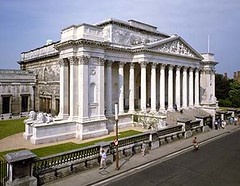 In 1860, the famous topographer and archaeologist William Martin Leake bequeathed his coin collection to the museum for the modest sum of 5,000 Pounds.
In 1860, the famous topographer and archaeologist William Martin Leake bequeathed his coin collection to the museum for the modest sum of 5,000 Pounds.
The money could have been taken from the building funds – a member of the museum advisory board, however, strongly protested against that. His opponent became the archaeologist Churchill Babington who campaigned for the purchase in a booklet. He was a visionary and envisaged that an active coin cabinet would attract further private collections.
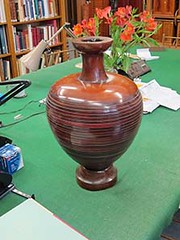

Coin Cabinet in the Shape of a Vase!
Leake‘s collection is stored in a place separated from the other coins until the present day. The wooden caskets in which some private collections came into the museum are real beauties that contribute to the distinctive atmosphere of the museum's study rooms.
Anyone fond of nostalgia will find in the Fitzwilliam Museum the typical feature of all coin cabinets of earlier days: a unity of collection, library and research. By the look at the cramped place, with the work stations in a localized manner, the visitor might find it hard to believe that Cambridge is the world's leading research center for medieval numismatics.
Ted Buttrey, Keeper of the Coins from 1988 until 1991, likewise made good use of his "retirement" to turn the Fitzwilliam Museum into a center of research: he collected auction catalogues and was especially fond of those pieces others toss away. He intends to document the entire material available on the market. In 2009, Ted Buttrey was able to celebrate his 45,000th catalogue!
Apart from that, the cheerful scholar has become a distribution center. Universities and museums all over the world provide him with checklists of missing auction catalogues. Ted Buttrey sends his duplicate copies. The postal charges he pays out of his own pocket.
Anyone who doesn't have an immediate chance to visit the Fitzwilliam Museum ought to have a look at the excellent internet presentation. Some of the special exhibitions are digitally documented there.
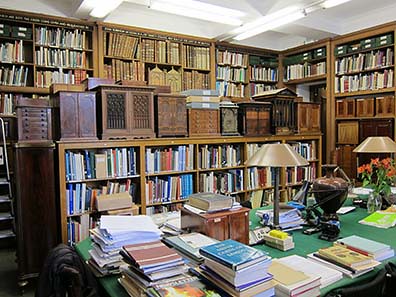
To read the complete article, see: Medieval times in focus – the Coin Cabinet in the Fitzwilliam Museum / Cambridge (www.coinsweekly.com/en/News/4?&id=533)
To read my diary entry for the Fitzwilliam, see: WAYNE'S LONDON DIARY 22 JULY, 2007 (www.coinbooks.org/esylum_v10n29a15.html)
To visit the Fitzwilliam Coin Cabinet web page, see: www.fitzmuseum.cam.ac.uk/dept/coins/
THE BOOK BAZARRE
MORE ON TRUTH IN LABELING FOR PRINT ON DEMAND LISTINGS
The strange, lengthy book title hit me right between the eyes. It read "Medal: Sculpture, Molding (process), Casting (metalworking), Machine Press, Stamping (metalworking), Insignia, Portrait, Medallic Art, Devotional Medal, Exonumia, Militaria, Pendant, Commemorative Plaque [Book]." Whew!
Was that a list of chapters or a book title? Published in 2010 by Alphascript Publishing, It stated 180 pages and its appended ISBN number.
A little pricey at $70, but if all that was in one book it would be worth it. I was interested. I printed the one-page data sheet off the internet. But before I hit the "add to shopping list" button I got the call to dinner.
After dinner my son, visiting from Cleveland, joined me in the office. He picked up that page and handed it to me. "You know, of course, this is all copied from Wikipedia?" "What!" I exclaimed. "Is that legal?"
This German publisher gathers a group of related items from Wikipedia, designs a colorful cover, prints and binds it all together in one pamphlet. And, yes, its legal. In this case, a 180-page pamphlet sells for $70. That's about 39 cents a page that you could print yourself for free from Wikipedia. Bit of a scam?
"How can I find out more about this outfit?" I asked my son. "Check out VDM Publishing on Wikipedia," he said, as he brought it up on the screen.
This is a legitimate self-publishing firm in Germany. They publish under the title Alphascript, Betascript and Fastbook Publishing, all English names, and Doyen Verlag in German among 14 other imprints. They specialize in publishing anything any author sends to them. There is NO editing, no fact checking, no peer review, no proofreading, no additional illustrations -- whatever the author sends is what they print and bind. They do add a color cover, but the covers all look alike with only one illustration per cover.
The firm specializes in print-on-demand and publish, so they claim, over 10,000 new titles a year. In 2007 they had 70 employees.
A major part of their in-print list are academic dissertations and research reports. They invite these from every university and print those in English, German, Russian, Spanish and French only. The firm offers one copy free to each author who accepts their proposal to print their work.
For what they copy from Wikipedia, as long as they state these are, indeed, from Wikipedia they are home free. It is legitimate. They can charge whatever they wish by selling free information. It is the buyer's decision.
The VDM mastermind is Wolfgang Philipp Muller, who founded Verlag Dr Muller -- that's the VDM initials -- in Dusseldorf in 2002. He moved to Saarbrucken in August 2007. The book titles are listed on Amazon (in America and UK), Lightning Source, and Books on Demand in Germany.
The Wikipedia VDM entry has a section critical of VDM's publishing practice. But it also includes a convincing VDM retort for reprinting Wikipedia articles:
Wikipedia is a valuable, quality resource, that the company has no problem asking authors for content, that buyers are informed of where information comes from, that books are a convenient form to collect articles about interesting subjects, and that its customers are satisfied with VDM's products.
To learn more click on: VDM Publishing (en.wikipedia.org/wiki/VDM_Publishing)
To read the earlier E-Sylum articles, see:
NEW YORK TIMES: FURTHER THOUGHTS OF A NOVICE E-READER
(www.coinbooks.org/esylum_v13n24a24.html)
TRUTH IN LABELING NEEDED FOR PRINT ON DEMAND LISTINGS
(www.coinbooks.org/esylum_v13n25a22.html)
BEP LAUNCHES EYENOTE APP TO HELP THE BLIND
 The Bureau of Engraving and Printing (BEP) has developed a free downloadable application (app) to assist the blind and visually impaired denominate US currency. The app is called EyeNote™. EyeNote™ is a mobile device app designed for Apple iPhone (3G, 3Gs, 4), and the 4th Generation iPod Touch and iPad2 platforms, and is available starting today through the Apple iTunes App Store.
The Bureau of Engraving and Printing (BEP) has developed a free downloadable application (app) to assist the blind and visually impaired denominate US currency. The app is called EyeNote™. EyeNote™ is a mobile device app designed for Apple iPhone (3G, 3Gs, 4), and the 4th Generation iPod Touch and iPad2 platforms, and is available starting today through the Apple iTunes App Store.
EyeNote™ uses image recognition technology to determine a note's denomination. The mobile device's camera requires 51 percent of a note's scanned image, front or back, to process. In a matter of seconds, EyeNote™ can provide an audible or vibrating response, and can denominate all Federal Reserve notes issued since 1996. Free downloads will be available whenever new US currency designs are introduced. Research indicates that more than 100,000 blind and visually impaired individuals currently own an Apple iPhone.
The EyeNoteTM app is one of a variety of measures the government is working to deploy to assist the visually impaired community to denominate currency, as proposed in a recent Federal Register notice. These measures include implementing a Currency Reader Program whereby a United States resident, who is blind or visually impaired, may obtain a coupon that can be applied toward the purchase of a device to denominate United States currency; continuing to add large high contrast numerals and different background colors to redesigned currency; and, raised tactile features may be added to redesigned currency, which would provide users with a means of identifying each denomination via touch.
More information is available at www.eyenote.gov or through email at eyenote@bep.gov.
To read the complete press release, see: Bureau of Engraving and Printing Launches EyeNote™App to Help the Blind and Visually Impaired Denominate US Currency (www.moneyfactory.gov/images/EyeNote_Press_Release_4_4-19_2_4.pdf)
- OneTouch, hand-held operation.
- Face or back of note to camera.
- Partial note recognition (note can be handheld).
- Any circular orientation.
- No equipment modification, special background materials or special lighting required.
- Camera flash is not required.
- No data connection required - all processing on device.
- Currency designs from Series 1996 and forward.
- Note can be on a complex background.
- 2-4 second response time.
- User selectable spoken output English or Spanish, based on device language setting.
- Spoken mode also indicates the front or back of note to assist in vending use.
-
Privacy mode when discretion is needed uses vibrations on the iPhones and audible tones on iPod Touch and iPad2.
- One Dollar is 1 pulse.
- Two Dollars is 2 pulses.
- Five Dollars is 3 pulses.
- Ten Dollars is 4 pulses.
- Twenty Dollars is 5 pulses.
- Fifty Dollars is 6 pulses.
- One Hundred Dollars is 7 pulses
- Error, reposition is 8 rapid pulses.
- Does not authenticate real notes from counterfeit.
To read the complete brochure, see: The EyeNote™ App (www.eyenote.gov/EyeNote_Brochure_V10.pdf)
APP REVIEW: THE E-SYLUM
Regarding our experimental E-Sylum iPhone app, Bill Eckberg writes:
The iPhone app seems to work fine. It would be much more useful to me if it worked natively on the iPad as well. The iPhone screen is pretty small for looking at lots of text and graphics, as Dick Doty commented. The app will run on the iPad, but it runs on an iPhone sized screen. You can double the size of the screen, but it doesn't increase the resolution. That just makes everything look fuzzy.
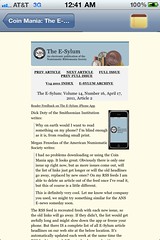 Speaking of apps, The Numismatic Bibliomania Society has created an app for its electronic newsletter, The E-Sylum.
Speaking of apps, The Numismatic Bibliomania Society has created an app for its electronic newsletter, The E-Sylum.
For those who have not heard of The Numismatic Bibliomania Society, NBS promotes the use and collection of all types of numismatic literature. The E-Sylum is their weekly electronic newsletter sent to email subscribers interested in numismatic literature and other topics of interest. It can be best described as eclectic with news, reviews, interesting numismatic tidbits, and discussions from a broad range of numismatists, authors, and collectors. It is worth subscribing or reading the issues on line.
While catching up with reading back issues, I found the announcement and immediately downloaded the free app from iTunes App Store. After a quick sync, the application was on my iPhone and ready to use.
As with many apps, it opens with a splash screen with the NBS logo. After a few seconds, the app presents a list of articles from the most recent edition. So far so good as I tapped on the entry for the reader feedback on the app. I was then presented a page with the title of the article and a link that says "Read More." I am not sure why the app does this. It should open the page with the text of the story. For me, this type of interface tends to become monotonous and turns me off to the app.
After pressing "Read More" I open up the web page from the NBS site with the story. The problem with this is that the article's formatting is for a webpage to be read on the computer. This makes the text smaller and requires additional manual manipulation in order to read the article. I know it is possible for a website to tell what type of device is reading it. NBS should consider updating the style of the page to display better for the smaller phone screen when being read by the app.
I really wanted to like this app but these issues may prevent me from using it on a regular basis. I hope that these issues will be fixed in a future release. Right now, I would give the app a grade of AU-58, just short of being mint state because of that blue screen that does not seem to do anything. I hope that NBS fixes the app because I really want to like it!
To read the complete article, see: The E-Sylum App (coinsblog.blogspot.com/2011/04/e-sylum-app.html)
APP REVIEW: COIN WORLD IPAD APP
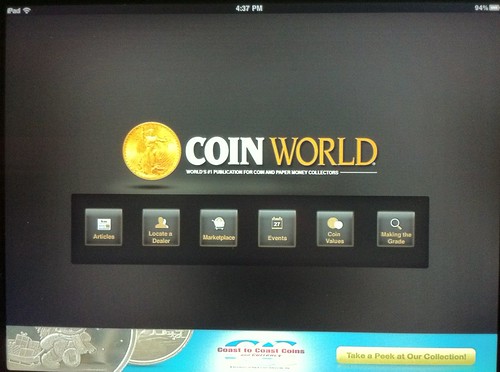
Coin World has been hyping its new free iPad app for a while. I looked for it several times after its announcement, and finally it appeared. I downloaded it and tried it. Three of the components are worthwhile, though two of those are quite limited.
When you launch it, a St. Gaudens $20 spins rapidly from the right side of your screen, uncovering the Coin World logo as it does so. Snappy looking, simple graphics, but no usefulness there. Then, a series of 6 buttons appears below: Articles, Locate a Dealer, Marketplace, Events, Coin Values, and Making the Grade.
Articles is the best part. It gives you access to the text and images from articles from at least recent issues. I didn't crosscheck to see if all articles were included, but some of the columns are. Articles from back issues are also available, but I didn't check to see how far back they go. A good thing about this is that the pictures can be enlarged by the usual iPad techniques of tapping and pinching. They don't enlarge very much, but this is still better than looking at the pictures in newsprint. If you already subscribe to Coin World, the added value is that breaking news appears on the iPad app before it appears in print or even in the electronic version of the magazine. If you subscribe to Coin World just to read the articles, you can get that free in the app.
Locate a Dealer gives you access to a US state map. You tap on a state, and a short list of dealers appears to the left. Inexplicably, dealer websites are NOT listed - just the (often incomplete) address and phone number. One hopes they aren't paying much for this advertising.
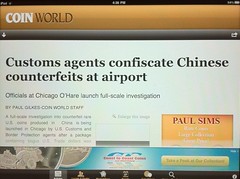
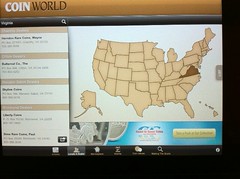
Marketplace is useful, though also limited in scope. It lists individual coins in categories. The listings are searchable, and as of this writing, there are 12,064 items listed. Many, but not all items are imaged. However, Collectors Corner Ezine gives access to about 4 times as many coins at this time. I presume that Coin World for iPad will eventually feature more comprehensive listings, but right now, that's it.
Events gives you a map similar to the one that helps you locate a dealer. Tap on a state, and up pops a list of upcoming shows. Each has an information button that gives you the information that appears in theCoin World classified listings. This is convenient, but the listings are quite limited. An upcoming local show in my area that always advertises was nowhere to be found.
Now we come to the annoying part. Coin Values and Making the Grade are not included with the free app. When you tap their icons, you get the option to buy. Coin Values Costs $4.99, and Making the Grade costs $9.99. The prices aren't exorbitant, but subscribers to Coin Values should get iPad access for no additional charge, and this is not offered. Also, there is no indication of how often your Coin Values subscription gets updated or for how long it is valid. Does it require renewal? If so, how often?
Making the Grade indicates that it "provides high quality images and detailed descriptions of each grade level of the top 50 most widely collected U.S. coins." The "top 50" are not identified, so you have to guess whether the coins YOU collect are included. There appears to be no way to get access to find out what these utilities are like without buying them. A search of the Apple App Store site found Coin World for the iPad, but neither of the two add-ons, so there was no way to get further information. Before shelling out $10 for a coin grading guide, I'd want to be sure it offered me more than the free PCGS Photograde HD that I already have. Without access to see what the utility is about, there is no way to guess what the added value might be.
The Coin World app is clearly intended as an advertising medium with enough news content added to encourage people to use it. At the present time, it is pretty limited as such, but it's probably worth keeping an eye on it for future developments. For now, this free app is worth the price, and that's about it.
THE 2011 BROOKGREEN GARDENS MEDAL BY SIMON KOGAN
Rich Jewell writes:
Last Sunday, April 17th, The Annual President's Council Reception was held at the Fountain of the Muses at Brookgreen Gardens. Special guest and sculptor Simon Kogan introduced the 2011 Brookgreen Medal "Garden of Liberty"
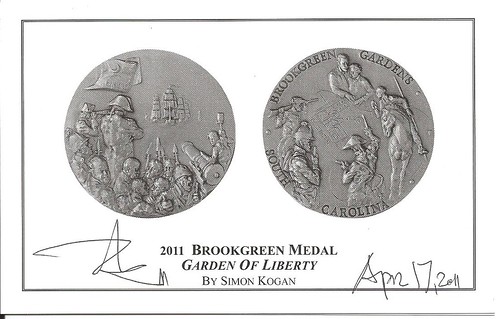
Here's an excerpt from another document Rich sent:
The 2011 Brookgreen Medal, Garden of Liberty by Simon Kogan, depicts South Carolina's historic past. Simon Kogan writes: "The road to the final design of the 2011 medal was educationally long. I lost myself in the history of South Carolina, spending countless hours in libraries and on the internet searching the information that would trigger my imagination. I went through tons of themes and sketches and them 'June 28, 1776' appeared... The Battle of Sullivan's Island.
RATS OF TOBRUK MEDAL RECIPIENT FRANCIS PETER BINGHAM
Name
BINGHAM, FRANCIS PETER
Service: Australian Army
Service Number: TX813
Date of Birth: 10 Jul 1914
Place of Birth:HOBART, TAS
Date of Enlistment: 27 Nov 1939
Locality on Enlistment: GORMANSTON, TAS
Place of Enlistment: HOBART, TAS
Next of Kin: BINGHAM, KATHERINE
Date of Death: 3 Aug 1945
Rank: Warrant Officer Class 2
Posting on Death: 2/3 Field Company
WW2 Honours and Gallantry: Military Medal
Prisoner of War: No
Roll of Honour: GORMANSTON TAS
Tony adds:
I agree the number 254 is probably the serial number of this unofficial medal. The Australian Official History of WW2 says Sapper Bingham wrote some verses regarding the laying of 5,000 mines in the front of 24th Brigade on the night of 11 April 1941. A note in the history states:
"WO2 F P Bingham Military Medal TX813 2/3 Field Company, Fitter of Gormanston Tas died of wounds accidentally received 3 August 1945
"23/24 Oct 1941 L/Cpl Bingham began to carry Lt Thomas out after being hit, Bingham shot a German with his pistol then bailed up three others who helped him carry Thomas back. A total of five German prisoners were brought in one Australian killed, 8 wounded and 7 missing."
To read the earlier E-Sylum article, see: More on the Rats of Tobruk Medal (www.coinbooks.org/esylum_v14n16a13.html)
KOLBE & FANNING JUNE 2, 2011 SALE HIGHLIGHTS
Part Two of the Alan Luedeking Latin American Numismatic LibraryIncluding: Long runs of seldom-encountered 20th-century American and
European auction sales featuring foreign and Latin American coins and medals;
Many elusive works by Burzio, Ferrari and others; Several original Medina works;
The fabled 1908 catalogue of the Gonzalez collection of Chilean coins; Runs
and sets of obscure and often rare Latin American numismatic periodicals
Catalogue Available at Our Web Site: www.numislit.com
Printed Catalogues $10.00
KOLBE & FANNING NUMISMATIC BOOKSELLERS
141 W JOHNSTOWN ROAD, GAHANNA OH 43230-2700
(614) 414-0855 • df@numislit.com • GFK@numislit.com
MORE ON MEDAL OF HONOR CERTIFICATES
Fred Schwan writes:
You are certainly correct, Medal of Honor award certificates are indeed more rare than the medal itself. The certificates get lost, torn and otherwise become unavailable. Of course this is true for most award certificates, not just the MOH.
The certificate that the article pictures is not an original certificate. First, I must say that I do not know for sure that certificates were awarded during the Civil War, but I was sure that the text of the certificate that you illustrated was not such. I did not know the Medal of Honor Legion text so I looked that up. The legion was not formed until ca. 1890 so the certificate could not have been issued with the medal.
Interestingly, the legion was created in part to promote and honor legitimate holders of the Medal of Honor. That is a mission similar to the recently found unconstitutional Stolen Valor Act.
Here is an example of a pre-printed form letter which was sent with the Civil War MOHs. Note the hand stamp which reads, in part, BOUNTY PAID $1.00 1867. It was signed by the Assistant Adjutant General, War Department.
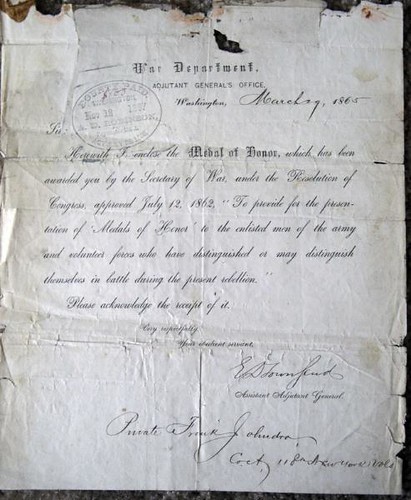
David Klinger writes:
I don't have the same take on that Medal of Honor certificate as Fred does. This from the Medal of Honor Society web page:
"680 of the eventual 1520 total Medals awarded for Civil War actions (not counting those of the 27th Maine), have been presented. From 1866 to 1890 a total of 105 more will be awarded. From 1890 to 1899 more Medals will be awarded for Civil War action than were awarded during the war...a total of 683 in the last decade of the century."
This means that all (or at least some) of those MOH certificates awarded in the last decade of the century could be "original". This is especially probable, since I have been told, and I believe, that certificates were not issued with the medals before the Medal of Honor Legion was formed in 1890. It was sometime later that the individual military services started to issue certificates with medals. I have seen letters (but not certificates) sent with medals to next of kin for posthumous Civil War era awards.
NOTES FROM E-SYLUM READERS: APRIL 24, 2011
Tom DeLorey writes:
Apropos Secret Service agents taking ANA seminar courses, I had an agent take my counterfeit detection course back in the early 1980's. I contacted him before the seminar and asked him if he would have a problem with us using counterfeit U.S. coins from our reference collection, and he said no, that he recognized that we held them for legitimate educational purposes. He went on to say that the Secret Service appreciated ANACS' existence, because they received dozens if not hundreds of counterfeit or altered coins every year from people who had received them back from us along with a printed suggestion that they surrender them to the Secret Service.
He also said that the Secret Service wanted to learn how to detect counterfeit and altered coins because up until then they had to rely upon the Mint Laboratory to rule upon suspected coins, and it usually took them several months to return a verdict.
To read the earlier E-Sylum article, see: On Mr. 880 and Mark Surrency's Counterfeits Class (www.coinbooks.org/esylum_v14n16a12.html)
David E. Schenkman writes:
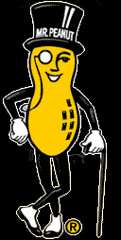 The Planters Nut & Chocolate Company tokens are listed in Virginia Tokens, a book I wrote in 1980. There are five denominations, all aluminum: 5 (19mm), 10 (25mm), 25 (29mm, 50 (32mm), and 100 (35mm). In the early 1970s I corresponded with an employee of the company and, after several months of searching he found me all five tokens. According to him, use of the tokens was discontinued circa 1937.
The Planters Nut & Chocolate Company tokens are listed in Virginia Tokens, a book I wrote in 1980. There are five denominations, all aluminum: 5 (19mm), 10 (25mm), 25 (29mm, 50 (32mm), and 100 (35mm). In the early 1970s I corresponded with an employee of the company and, after several months of searching he found me all five tokens. According to him, use of the tokens was discontinued circa 1937.
In the late 1960s Carmen Valentino, who at the time was a member of the Token and Medal Society (TAMS), was representing S. H. Quint's Sons Company of Philadelphia, selling their old trade token dies. I purchased many Virginia token dies, including all ten dies used to strike the Planters tokens
To read the earlier E-Sylum article, see: Query: Planters Nut & Chocolate Company Token Information Sought (www.coinbooks.org/esylum_v14n16a14.html)
Harry Waterson writes:
This would be a fascinating day learning about restoring old bronzes. Always a major issue among collectors of old coins and medals.
Restoring Ancient Bronzes in the Nineteenth Century
Date: Friday, May 6, 2011
Time: 9:30 a.m.–5:30 p.m. with reception to follow
Location: Getty Villa, North Campus Meeting Rooms
Registration: Free; preregistration is required and seating is limited. Please e-mail villaprograms@getty.edu by Monday, May 2.
Presented in conjunction with the exhibition Apollo from Pompeii: Investigating an Ancient Bronze on view through September 12, 2011 at the Getty Villa, this one-day program considers the wider context of bronze restorations in the nineteenth century, utilizing both archival research and technical analysis. With the Apollo Saettante as a starting point, restoration work in Naples will be of primary interest, but speakers will also consider comparable activities throughout Italy and elsewhere in Europe.
Key themes include methods and materials used; approaches to ancient surfaces and re-patination; the development of technical knowledge; the role of modern bronze foundries and industrial production; and individual restorers and their working relationships.
Confirmed speakers:
- Sophie Descamps, Musée du Louvre, Paris, France
- Lucia Fucito, Fonderia Chiurazzi, Naples, Italy
- Seán Hemingway, The Metropolitan Museum of Art, New York, New York
- Henry Lie, Straus Center for Conservation and Technical Studies, Harvard Art Museum, Cambridge, Massachusetts
- Carol C. Mattusch, George Mason University, Fairfax, Virginia
- Luigia Melillo, Museo Archeologico Nazionale di Napoli, Naples, Italy
- Erik Risser, J. Paul Getty Museum, Los Angeles
- David Saunders, J. Paul Getty Museum, Los Angeles
- Salvatore Siano, Istituto di Fisica Applicata Nello Carrara, Florence, Italy
To read the complete article, see: Restoring Ancient Bronzes in the Nineteenth Century (www.getty.edu/museum/symposia/restoring_ancient_bronzes.html)
"I READ IT IN THE WHITMAN REVIEW!"
BALDWIN'S CHINESE COIN AUCTION RESULTS
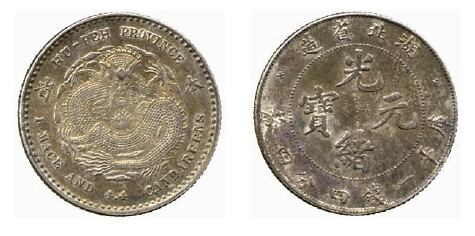
Baldwin's auction department had a lot to celebrate last Thursday night after the outstanding success of the Hong Kong Coin Auction 50 and the very first Hong Kong Watch Auction. Auction lots were selling for up to 30 times estimate as prices soared for the array of outstanding rarities on offer. The dynamic Baldwin/Ma Tak Wo collaboration achieved an impressive sale total of US$5,468,403, more than double the pre‐sale estimate. The sale took a staggering 14 hours to complete as bidders in the room and online battled it out, forcing prices through the roof.
There was no doubt that the Hong Kong Auction 50 was going to be a success with the partnership eager to mark the 25th anniversary of their involvement in the Orient. The coin industry always appreciates material fresh to the market. Many of the coins in this auction came from an old European collection, while much of the balance was consigned by a local Hong Kong collector who had bought most of his coins decades ago, while living in California. Bidders seemed to be out in force and some of the highest prices were paid for rarities and high grade coins in original condition.
The sale was packed full of classic pieces as well as top end rarities, which far exceeded pre‐sale expectations. Lot 479 (pictured above), a Hupeh Province silver "Ben Shen" 20‐Cents, was the star of the classic rarities cast, a coin so rare that it was missing from all the major Chinese collections sold in recent years. A modest pre‐sale estimate of US$40,000‐50,000 was smashed with the lot achieving an astounding US$150,000, selling to a Chinese bidder. Other exceptional lots included lot 487, a 1904 Hupeh Province Silver Tael which carried a pre‐sale estimate of US$2,000‐2,500 but eventually sold in the room for US$65,000; lot 524, a 1900 Kiangnan Province Silver 50‐Cents, estimate US$6,500‐8,500, sold for US$100,000 and lot 610, a 1908 Kirin Province Silver dollar which achieved an amazing US$150,000 against a pre‐sale estimate of US$4,000‐5,000. The highest selling coin, lot 914, was proof positive that modern rarities are just as popular as their classic counterparts. The 1999 Gold Proof 2000‐Yuan with certificate number 8 (a most auspicious number in Chinese culture) sold for an incredible US$280,000 against a pre‐sale estimate of US$200,000–250,000.
Prices Realised form both auctions can be found online at www.baldwin.co.uk/auction‐results . Baldwin's will be holding their next Hong Kong Coin Auction No. 51‐52 on the 24th – 25th August and a second Hong Kong Watch Auction is scheduled for 2012.
TERMITES EAT MILLIONS OF INDIAN RUPEES IN BANK
It was an all you can eat buffet at the bank.
An army of termites munched through 10 million rupees ($222,000) in currency notes stored in a steel chest at a bank, police in northern India said Friday.
The bank manager discovered the damage when he opened the reinforced room in an old bank building on Wednesday, police officer Navneet Rana told The Associated Press.
"It's a matter of investigation how termites attacked bundles of currency notes stacked in a steel chest," he said. The money was put in the chest in January.
The termites had damaged bank furniture and documents in the past.
The police have registered a case of negligence against bank officials in Barabanki, a town 20 miles (30 kilometers) southwest of Lucknow, the Uttar Pradesh state capital.
To read the complete article, see: Termites eat millions of Indian rupees in bank (news.yahoo.com/s/ap/as_india_termites)
THE VATICAN COIN AND MEDAL COLLECTION
Alan V. Weinberg writes:
If you watched 60 Minutes on CBS last Sunday, the Morley Safer segment covering the widely-unknown and largely unseen Vatican Library covered in part the Library's apparently extensive coin and medal collection, formed since the 1400's, and the librarian held (in his palm as is the practice I've noticed with ancient silver coins) two superb condition silver ancient Greek coins up to the camera lens- both of which I recognized including a Syracuse decadrahm - and in the background a large gold medallion.
 The Numismatic Cabinet or Medagliere of the Vatican Library preserves coins, medals, seals, foil strips, plaques, engraved stones, casts, and other similar materials. It also keeps the official pontifical medals and coins. The collection includes about 300,000 pieces.
The work of the Department consists of inventorying, classifying and cataloguing this material, and making it available to scholars.
Il Catalogue of coins and medals is available on-line.
The Numismatic Cabinet or Medagliere of the Vatican Library preserves coins, medals, seals, foil strips, plaques, engraved stones, casts, and other similar materials. It also keeps the official pontifical medals and coins. The collection includes about 300,000 pieces.
The work of the Department consists of inventorying, classifying and cataloguing this material, and making it available to scholars.
Il Catalogue of coins and medals is available on-line.
The origin of the Vatican Medagliere is generally believed to go back to Pope Marcellus I (1555), who, when he was still Cardinal Librarian, is said to have donated his collection to the Vatican Library. It was made up of many rare pieces, including a large number of ancient coins.
In fact, however, it is not until the pontificate of Clement XII Corsini (1730-1740) that we find the beginnings of a numismatic collection worthy of the name in the Medagliere of the Vatican Library. In 1738, Clement XIII acquired the famous collection of 328 Greek and Roman medals which belonged to Cardinal Alessandro Albani, especially for the Vatican Medagliere, which had been relatively neglected up until then. The same access restrictions as had been established by Sixtus V for books and manuscripts were applied to this fundamental nucleus of medals, and one can say that it is from here that the entire history of the pontifical Medagliere had its beginnings.
Between 1741 and 1743, Pope Benedict XIV Lambertini decided to acquire another famous collection, that of Cardinal Gaspare Carpegna, which included not only coins and medals, but also thousands of tesserae, cameos, small bronzes and jewels. The work of inventorying this immense collection lasted for almost two years; but in 1743, Msgr. Giuseppe Simone Assemani, "Primo Custode" of the Vatican Library and a keen numismatist who had already compiled the inventory of the Albani collection, was able to add the over 4,000 pieces of the Carpegna collection to the Medagliere.
A few years later, again upon the initiative of Pope Lambertini, the no less famous collection of about 5,000 pontifical coins which had belonged to the well-known numismatist Saverio Scilla became part of the Vatican Medagliere. This collection included a number of unique pieces; the Pope had cases constructed out of walnut wood in order to provide a fitting home for the entire numismatic collection.
In most recent times the Medagliere has grown further, especially by additions of pontifical and other modern medals, thanks to donations and purchases: the donation of medals by Luciano Zanelli, made by the artist himself; the donation of the medals of Pietro Giampaoli, made by the heirs of the famous medalist; the donation of medals from the Western world from the sixth century B.C. to the twentieth century, made by the collector Msgr. Salvatore Nicolosi; the donation of medals by the artist Pezzetta, made by his heirs.
The collections which today distinguish the Vatican Medagliere and are its main source of pride are certainly those of pontifical coins, of pontifical medals and of Roman coins, especially from the Republican period. However, other collections are also important and contain many rare or even unique pieces, in particular the collections Greek, Byzantine, Medieval and Oriental (especially Chinese) coins. Also noteworthy are the collections of pontifical and Byzantine lead seals (or "bulls"); of Roman lead tesserae; of over 10,000 plaster, glass or sulfur casts of medals and gems; of 800 engraved Roman gems; of pontifical, Italian, and other decorations. The technical library is also rich in books, many of which are old or rare, and which complete the numismatic collection of the Popes, one of the world's richest collections and certainly its most famous one.
To visit the Vatican Library Numismatic Collection web page, see: Department of the Numismatic Cabinet (www.vaticanlibrary.va/home.php?pag=dipartimento_numismatico&ling=eng&BC=11)
THE BOOK BAZARRE
U.S. GOLD COIN HOARD FOUND IN EAST LONDON RETURNED TO OWNER'S FAMILY
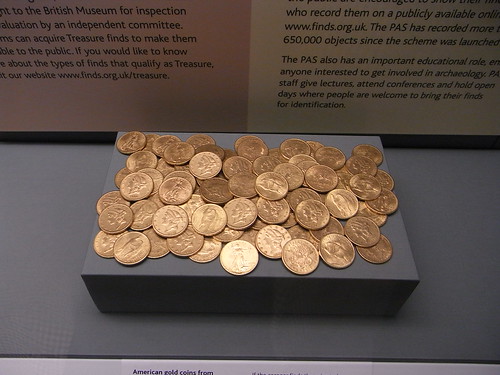
A hoard of gold coins smuggled to London by a Jewish man who fled Nazi Germany will be returned to his descendants, a coroner has ruled.
Max Sulzbacher's family buried the jar of "double eagle" gold dollars in the garden of their home in Hackney.
But they were killed when a bomb hit their house during the Blitz, taking the details of where the coins were with them.
The coins, now being sold, are expected to fetch £80,000 at auction.
They were minted between 1854 and 1913, and will be available to bidders at Spink auctioneers in Bloomsbury, London.
The coins were found wrapped in greaseproof paper by Terrence Castle of Stoke Newington, north-east London, in the summer of 2007 while he was digging a frog pond in the garden of the property with three other people.
Mr Sulzbacher, 81, a retired chartered accountant who lives in Jerusalem, said that he would be using the proceeds of the sale to give the finders of the coins a reward and to restore his family's gravestones at Enfield cemetery, north London.
He said he was "surprised and delighted" by the find.
Mr Sulzbacher's father, Martin, smuggled the coins to England, having sold all of the family's possessions in Germany.
He was sent abroad to Canada at the outbreak of war, but when then the ill-fated Arandora Star he was on was torpedoed and sunk, he was sent to Australia.
His wife and four children, including Max, were interned on the Isle of Man.
His mother and father, brother Fritz, his sister and sister-in-law remained in London and buried the coins, before being killed by a German bomb.
On his release, Martin Sulzbacher unsuccessfully had the garden searched.
Some identical coins were found at the property in 1952 and he was able to claim them.
It was that information that helped the British Museum, the coroner's office and the Museum of London to trace Max Sulzbacher this time.
To read the compete article, see: Gold coins returned to family of Jew who fled Nazis (www.bbc.co.uk/news/uk-england-london-13128903)
The return of the hoard, now worth about £80,000, means the four now-elderly children of the original owner will be able to afford new gravestones at the Jewish cemetery in Enfield for the grandparents, two aunts and an uncle killed on September 24, 1940, when a bomb fell on the family home in Hackney.
Max Sulzbacher, 81, a retired chartered accountant, said: "The tombstones were poor quality during the war. They have disintegrated and now we know how to pay for new ones."
The coins were discovered three years ago by the current residents when they were gardening. Opening an inquest into the find last October, coroner Dr Andrew Scott Reid gave any claimants until this spring to come forward. The publicity alerted British Museum experts to a 1952 report of a similar find on the same site, which helped them unfold the astonishing story of Martin Sulzbacher, Max's father, and his family. Martin Sulzbacher, a German Jew, fled to Britain in 1938. When war broke out, he was interned as an enemy alien and sent to Australia, while his wife and four children, including Max, were held on the Isle of Man. The remaining family stayed in Hackney. When the risk of invasion grew, they decided Mr Sulzbacher's savings should be buried in the garden.
To read the complete article, see:
(www.thisislondon.co.uk/standard/article-23942289-family
-win-back-their-buried-gold-coins-70-years-on.do)
To read the earlier E-Sylum article, see: U.S. GOLD COIN HOARD FOUND IN EAST LONDON GARDEN (www.coinbooks.org/esylum_v13n43a23.html)
STOLEN WWII DISTINGUISHED SERVICE ORDER MEDAL RETURNED TO OWNER
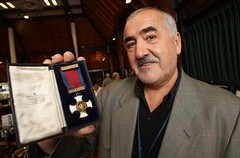 A rare war medal missing for three years was returned to its owner just in time to appear at a Tauranga antique fair at the weekend.
A rare war medal missing for three years was returned to its owner just in time to appear at a Tauranga antique fair at the weekend.
The medal's owner, Peter Zervos of Ikon Antiques and Militaria, said the unique piece was returned only a week ago after being stolen from a gun fair in Auckland in 2008.
"It just appeared - a woman tried to sell it to a jeweller, who recognised it because they are so rare. This would be the only one in New Zealand," he said.
The medal was a Distinguished Service Order (DSO) awarded to a Romanian major during World War I.
"It was very rare because usually only British subjects were awarded that," Mr Zervos said.
He found the piece in an antique shop in Bucharest, Romania, about 10 years ago.
The return of the medal was a timely piece of good luck for the antique dealer - his Lyttelton home was "flattened" in the Christchurch earthquake.
To read the complete article, see: Stolen war medal returns to add sparkle to show (www.flickr.com/photos/coinbooks/5636705836/in/photostream)
FAKE U.S. COINS FROM CHINA SEIZED AT CHICAGO AIRPORT
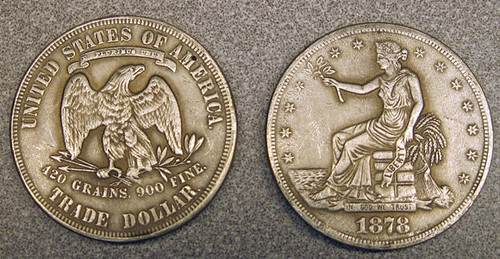
U.S. Customs agents this week seized a shipment of counterfeit money shipped in from China -- not fake 20s, 50s or 100s, but fake 19th century coins made to look like U.S. silver money that was circulated widely in China.
The fake coins likely were meant to take advantage of renewed interest in coins made from precious metals. The shipment is among the first from China that federal agents in Chicago have come across, authorities said.
The shipment of coins arrived in Chicago via the mail and was stopped by U.S. Customs agents after they found an "anomaly" when a heavy package being sent to an Illinois resident was X-rayed, according to a news release from U.S. Customs and Border Protection.
When officers opened the package, they found 361 coins made to look like Trade Dollar coins dated between 1873 and 1878, the years the Trade Dollar was minted to take advantage of high demand in China for silver coins.
Some authentic Trade Dollars can fetch as much as $2,000 each on the collecting market, according to the news release.
Customs officers sent a sample coin to the agency's Chicago laboratory for analysis, and the lab found the coins were not silver, but brass with a thin silver-plate, according to the news release.
The man the coins were supposed to be going to contacted Customs asking about his shipment when he noticed that it had not been delivered on time, saying he was going to sell the coins on an auction website. But when the lab results came back on Tuesday, Customs seized the shipment.
The find of the fake coins is unusual, Chicago-based Customs spokesman Brian Bell said today.
"This is actually one of the first ones that we've seen in Chicago, and we've put word out to our other stations to be on the lookout for them," Bell said.
To read the complete article, see:
Fake 19th century coins seized at O'Hare
(www.chicagotribune.com/news/local/breaking/chibrknews
-fake-19th-century-coins-seized-at-ohare-20110422,0,2002139.story)
VERMONT ARTIST CREATES FURNITURE USING COINS
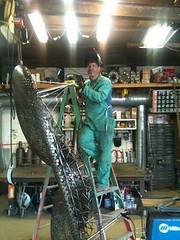 If a Vermonter has $100,000, he might buy a tractor, says artist Johnny Swing. Vermonters with spare change are unlikely to plunk down $100,000 – or more — on a couch made of nickels.
If a Vermonter has $100,000, he might buy a tractor, says artist Johnny Swing. Vermonters with spare change are unlikely to plunk down $100,000 – or more — on a couch made of nickels.
"I have no work in Vermont," Swing, 49, said.
But 23 people have purchased the nickel couches Swing designs and makes in his Brookline studio, he said. Hurry, if you want to buy one: the price is going up!
Swing sold his first nickel couch in 2001, for $12,000. The most recent sale of a similar piece was two years ago, for $105,000, he said. At Knoedler and Company, a New York gallery, the piece is for sale for $140,000.
Swing's couch is made with 6,800 nickels, and has 35,000 welds. It weighs 130 pounds and takes about three months to build, he said.
"I'm perfectly happy to be considered a designer," Swing said. "I don't mind if people refer to the work as furniture — as long as people respond to them and relate to them. I don't want to be pompous by calling them art. If people need to create access by calling them furniture, that's fine."
Using coins to create art began in New York City, where Swing made sculpture and installation art. His work included street-sign sculpture in which he welded coins to his pieces, and then bolted the sculpture to No Parking signs.
"Being a naturally cheap Wasp Yankee, we like to keep things around. We're thrifty people," Swing said. "Pennies are fairly inexpensive material. You can't buy a metal washer, let alone copper of that diameter and thickness, for at all close to that price."
He made a chair of pennies. Then he designed one using nickels. "Whoa!," he thought. "Lemme see if I go broke making them out of nickels. I didn't."
These days, Swing purchases his material from the bank in nearby Newfane. He makes a variety of designs, using nickels, quarters, half-dollars and dollar coins.
To read the complete article, see:
Brookline artist uses coins to create work
(www.burlingtonfreepress.com/article/20110417/ARTS04/110415025/
0/LIVING01/Brookline-artist-uses-coins-create-work)
QUEEN ELIZABETH'S BUSY WEEK
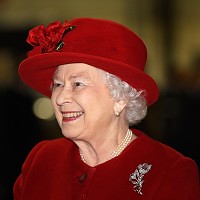 On Maundy Thursday, April 21st, Queen Elizabeth handed out Maundy coins. It occurred
this year on her 85th birthday, a first. It also represented Prince Philip's 90th
birthday, with her son's royal wedding just nine days away. How's that for a full
calendar?
On Maundy Thursday, April 21st, Queen Elizabeth handed out Maundy coins. It occurred
this year on her 85th birthday, a first. It also represented Prince Philip's 90th
birthday, with her son's royal wedding just nine days away. How's that for a full
calendar?
This year she dispenses specially minted Maundy coins to 85 men and 85 women, custom dictates the number matches her age. Each recipient receives two purses, one red, one white. The red purse this year contains a 50-pence coin marking the 2012 London Olympic Games. The white purse holds specially minted Maundy Money, silver coins of one, two, three and four penny pieces, the sum of which equals the Queen's age.
This year's Royal Maundy Service ceremony takes place at Westminster Abbey (location changes to a different church each year). The royal wedding will also take place at Westminster Abbey. Choristers and clergy for the royal wedding venue will be using the Maundy Easter ceremony to help them prepare for Prince William and Kate Middleton's nuptials, April 29th. Get your video cameras ready!
The Maundy custom will celebrate its 800th anniversary in 2013. It was British King John, who in 1213, gave alums,13 pence to each of 13 poor men -- the number being symbolic of the Twelve Apostles together with either Jesus or an angel. The custom changed in 1363 when Edward II gave fifty pence to 50 poor men, equal to his age. The first special Maundy coins were issued in 1689.
This week's news story:
Queen at Maundy service on birthday
(www.google.com/hostednews/ukpress/article/ALeqM5iFBNqZ5cXzoc
FW8ERM4xTLRHVBlA?docId=N0036771303301341927A)
THE CAMBRIDGE UNIVERSITY NORRISIAN PRIZE MEDAL
John Sallay writes:
The attached photo is to wish you and the readers of the E-Sylum a Happy Easter.
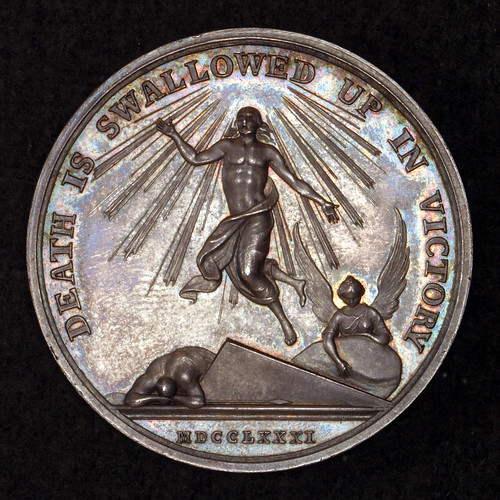
1781. Silver. Diameter 43.6mm, 37.5 grams. Obverse: Christ rising from the tomb, with an angel pulling away a stone and a guard sleeping nearby; DEATH IS SWALLOWED UP IN VICTORY around, and the date MDCCXXXI below the exergue line. Reverse: A Bible open to "S. John", with a cross above and the legend THE WISDOM OF GOD UNTO SALVATION around; NORRISIAN PRIZE below the exergue line.
According to Dr. Herbert J. Erlanger (Origin And Development of The European Prize Medal to The End of The XVIIIth Century, p.62), the Norrisian prize for theology was "established in 1781 by the will of John Norris Esq of Whitton in the county of Norfolk. He left the annual sum of £12 for the best essay by a candidate between the ages of twenty and thirty on a theological subject. £7.4/- of this was to go for a gold medal and the rest for a set of books, namely the Bible, Bishop Sherlock's Discourses, Leland against Deistical Writers and Pearson on the Creed.
Norris also endowed a Chair for theology and its incumbent each year proposed the subject on which the candidates for the Norrisian prize had to compose their essays strictly according to the doctrine, liturgy, articles and homilies of the Church of England. The medal was first given in 1781, and the successful candidates were required not only to have attended twenty lectures of the Norrisian professor of theology in one year but also to print and publish their winning essay."
To read the complete description on Neocollect, see: Cambridge University - Norrisian Prize (www.neocollect.com/item/3252/)
FEATURED WEB PAGE: LUXURY LIBRARIES IN EUROPE
This week's Featured Web Page is suggested by Don Cleveland. It is a set of PowerPoint presentations, one of which is " Luxury Libraries in Europe, Part 2". It's a jaw-dropping collection of photos of magnificent libraries. Check it out! Beautiful - bibliophiles will feel they've died and gone to heaven.
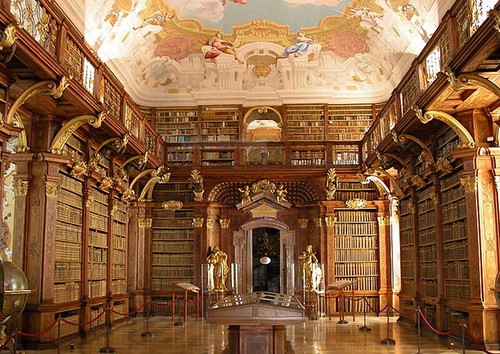
www.dtm-solutions.com/about/
powerpoints-travel.php
